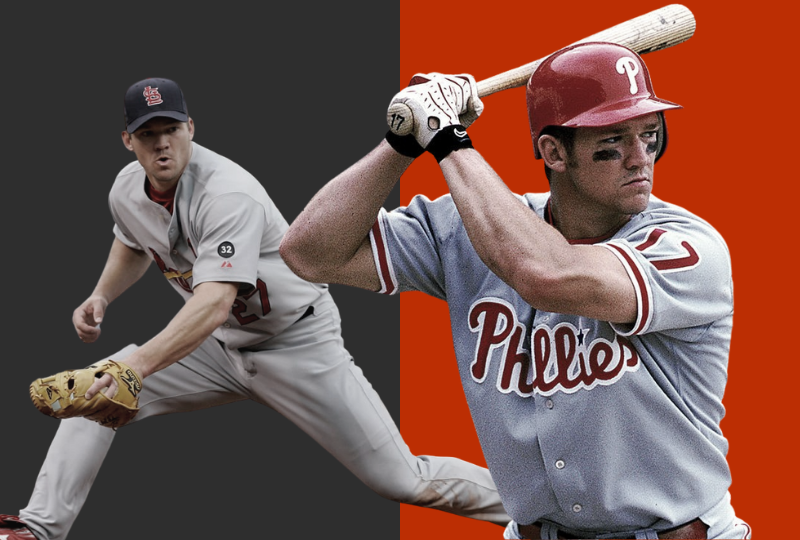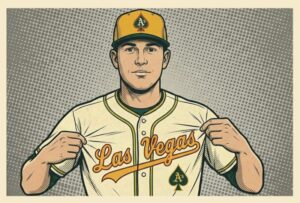The Baseball Hall of Fame voters are finally doing something about third base. On Tuesday, former All-Star third sacker Scott Rolen, the only player at his position to win a Gold Glove Award with three different teams, was elected to the National Baseball Hall of Fame.
Rolen is the only former player to have received enough votes for election in balloting by the Baseball Writers Association of America. He will be inducted with former first baseman Fred McGriff this summer in Cooperstown. McGriff was elected by a special committee last December.
Rolen won eight Gold Glove Awards, three with the Philadelphia Phillies, three with the St. Louis Cardinals, one with the Cincinnati Reds, and one in a season split with the Phillies and Cardinals. He was considered one of the best third basemen defensively since Mike Schmidt and Brooks Robinson. He won his first Gold Glove at the age of 23, and his final award at 38.
In 1997, Rolen was named National League Rookie of the Year, when he batted .283 with 21 home runs and 92 RBI. He also had 35 doubles and walked 76 times. Throughout his career he showed off doubles power, reaching 35 doubles six times. He walked nearly 900 times and posted a .364 on-base percentage. His career 855 OPS (on-base plus slugging) ranks sixth all-time among players who appeared in at least 1,500 games at the hot corner.
In 2004, Rolen helped the Cardinals to the pennant in arguably his finest season. He batted a career-high .314 with a career-best total in homers (34) and RBI (124). He won the Gold Glove and finished fourth in NL Most Valuable Player voting.
| PLAYER | VOTES | PERCENTAGE |
|---|---|---|
| Scott Rolen | 297 | 76.3 |
| Todd Helton | 281 | 72.2 |
| Billy Wagner | 265 | 68.1 |
| Andruw Jones | 226 | 58.1 |
| Gary Sheffield | 214 | 55.0 |
| Carlos Beltran | 181 | 46.5 |
| Jeff Kent | 181 | 46.5 |
| Alex Rodriguez | 139 | 35.7 |
| Manny Ramirez | 129 | 33.2 |
| Omar Vizquel | 76 | 19.5 |
| Andy Pettitte | 66 | 17.0 |
| Bobby Abreu | 60 | 15.4 |
| Jimmy Rollins | 50 | 12.9 |
| Mark Buehrle | 42 | 10.8 |
| Francisco Rodriguez | 42 | 10.8 |
| Torii Hunter | 27 | 6.9 |
| Bronson Arroyo | 1 | 0.3 |
| R.A. Dickey | 1 | 0.3 |
| John Lackey | 1 | 0.3 |
| MIke Napoli | 1 | 0.3 |
| Huston Street | 1 | 0.3 |
| Matt Cain | 0 | 0.0 |
| Jacoby Ellsbury | 0 | 0.0 |
| Andre Ethier | 0 | 0.0 |
| J.J. Hardy | 0 | 0.0 |
| Jhonny Peralta | 0 | 0.0 |
| Jered Weaver | 0 | 0.0 |
| Jayson Werth | 0 | 0.0 |
Rolen’s Numbers on Defense and Offense Rank Among Greatest Third Basemen in History
In large part due to a misunderstanding of advanced defensive statistics, many fans have been lukewarm to Rolen’s Hall of Fame case. But the numbers and narrative both support his election.
Only three third basemen have won more Gold Gloves than Rolen: Robinson with a record 16; Schmidt with 10; and Nolan Arenado also with 10. Among infielders, only 18 players have won as many as Rolen’s eight Gold Gloves. Nine of the 16 players on that list are in the Hall of Fame.
But Rolen was no one-way player: his 312 home runs as a third baseman rank 11th all-time; he ranks sixth all-time at his position in extra-base hits; and he’s in the top ten in total bases and times reached base among third basemen.
Among the Top 100 Third Basemen of All-Time here at Baseball Egg, Rolen is ranked ninth.
A product of the Phillies organization, Rolen naturally drew comparisons to Schmidt, the greatest third baseman of all-time. That was unfair, but Rolen handled the pressure well, averaging 26 home runs and 95 RBI in his four full seasons with the team.
His biggest moment came in 2004 in Game Seven of the NL Championship Series. With the Cardinals in a 2-2 tie with the Astros in the sixth, Rolen slugged a two-run home run off Roger Clemens to give St. Louis the lead they would never surrender, and the pennant.
In the 2006 World Series, Rolen batted .421 with a home run off Detroit’s Justin Verlander in Game One, helping the Cardinals to the championship. That season he had 48 doubles, 22 home runs, and 95 RBI, and naturally won the Gold Glove.
“He’s the best I ever saw coming in on a slow roller,” said Bruce Bochy, who managed against Rolen’s teams for many years in the National League. Rolen was renowned for his strong, accurate throwing arm.
Rolen’s career dWAR (Defensive Wins Above Replacemewnt) of 21.2 rank fifth in the history of baseball.
Rolen’s career Wins Above Replacement is ninth all-time among players who spent most of their career at third base. Every other player ahead of him, except Adrián Beltré, who is not yet eligible, has been elected to the Hall of Fame. Even more impressively, Rolen’s WAR per season of 5.6 rates fifth among inactive third basemen since 1900.
Wins Above Replacement Leaderboards for Third Basemen >
Too few Third Basemen in Cooperstown
The Hall of Fame now has 17 third basemen on its rolls. That’s the fewest for any defensive position (the Hall classifies three players as designated hitters).
However, Rolen is just the second player to primarily play third base who has been elected since Wade Boggs, who debuted in 1982, with Chipper Jones. In the last 50 years, since 1973, when both Mike Schmidt and George Brett debuted, the Hall of Fame has elected only five players who were really third basemen, including Rolen.
Part of the reason for the dearth of Hall of Fame third baseman, even going back to the start of the institution in 1936 (first ballot) and 1939 (doors opened) has been the difficulty in evaluating the defensive value of a player at the hot corner.
In the first half of the 20th century, third basemen were usually seen as “defense-first” players, valued for their range, hands, and throwing arm. Offense, if any, was considered a bonus. Only in the late 1930s and into the 1940s did many teams begin seeking power hitters for the position. Eddie Mathews changed how people looked at third base, but even after his brilliant career, and that of Brooks Robinson, who debuted in the 1950s, the Hall was slow to elect third basemen.
Of the four great 1960s third basemen (Mathews, Robinson, Ken Boyer, and Ron Santo), only two were ushered into Cooperstown with acclimation. Santo was finally elected 38 years after his final game, by a veterans committee. Boyer, who has credentials somewhat similar to those of Rolen, was on the ballot for 15 years but failed to earn as much as 30 percent support.
Among the best candidates for the Hall of Fame, several are third basemen, including Boyer, Graig Nettles, Buddy Bell, and Sal Bando.
While the Hall of Fame voting body has been comfortable electing “second-tier” players at the outfield and first base position, third basemen have typically had to be elite to get their plaque. Before his election, Rolen’s career bWAR of 70.1 was 11th among players not in Cooperstown. Four of the top 29 remaining on that list are third basemen.
Cardinals or Phillies? Which Team Cap Will be on Rolen’s Hall Plaque?
Controversy often arises over the cap a player is depicted wearing on his Hall of Fame plaque. Players are not inducted officially “as” members of certain teams, but many misguided fans get prickly over the distinction. When Greg Maddux was elected in 2014, he asked to have his cap logo blank, because he was torn between his allegiance to the Chicago Cubs, where he started his career, and the Atlanta Braves, where he won most of his Cy Young Awards and a World Series title. That decision rubbed some fans the wrong way.
Rolen played 844 games for the Phillies and 661 for the Cardinals. He played parts of seven seasons for Philadelphia, the team that drafted him, and parts of six seasons for the Cardinals, where he was part of two pennant-winning teams and a World Series champion. He had more hits, home runs, and RBI as a Philly, but his OPS+ was essentially the same with both teams (126 for the Phils and 127 for the Cardinals).
Ultimately, the Hall of Fame decides what cap logo, if any, appears on the plaque for an inductee. When Gary Carter was elected, the Hall overruled Carter’s desire to have a Mets logo, insisting his legacy would be better suited if his plaque featured the cap of the defunct Montreal Expos. That decision was made with baseball history in mind. But Rolen’s case could be trickier. It does seem that the Cardinals fan base more readily accepts Rolen as one of their own than the Philadelphia fans.







